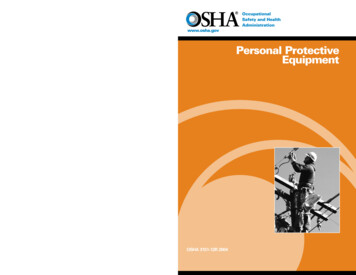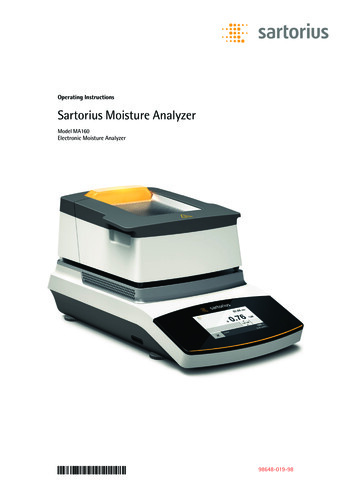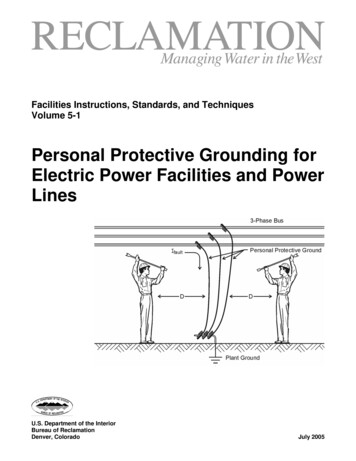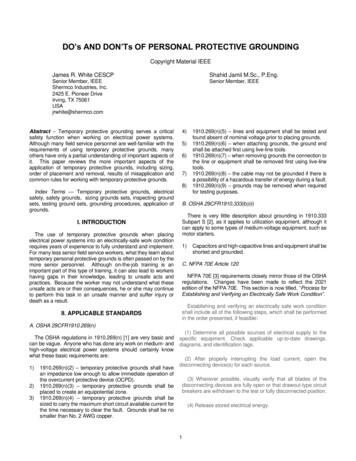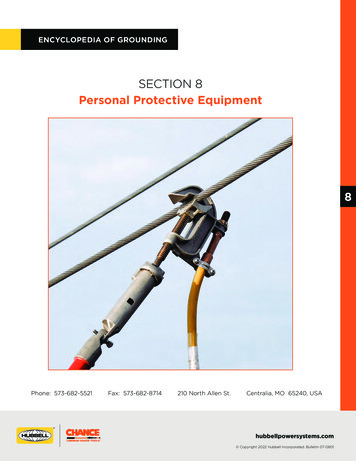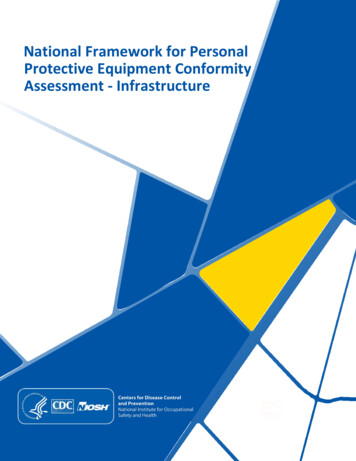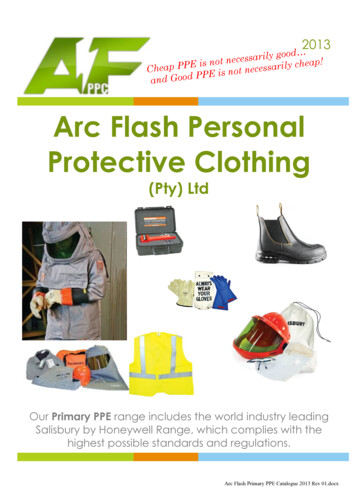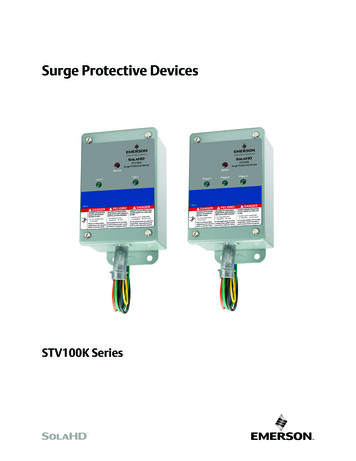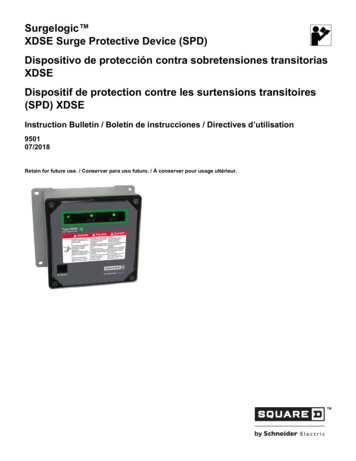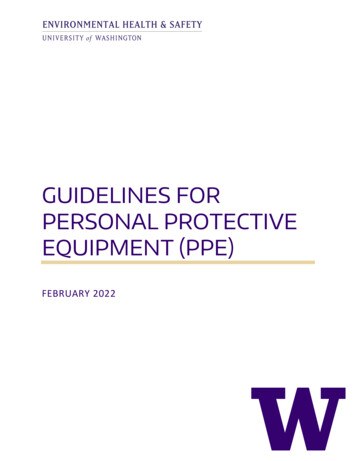
Transcription
WORKER HEALTH AND SAFETYPersonal Protective Equipment:Selecting the RightPPE for Pesticide UseOregon OSHA
Personal Protective Equipment:Selecting the RightPPE for Pesticide UseAbout this guidePersonal Protective Equipment: Selecting the Right PPE for Pesticide Use is anOregon OSHA Standards and Technical Resources publication.Piracy noticeReprinting, excerpting, or plagiarizing this publication is fine with us as long as it’s notfor profit! Please inform Oregon OSHA of your intention as a courtesy.
Table of ContentsEnvironmental Protection Agency’s chemical resistancecategories for personal protective materials . . . . . . . . . . . . . . . . . . . . . . . . . . . . . . . . . . . . 3Chemical-resistant gloves. . . . . . . . . . . . . . . . . . . . . . . . . . . . . . . . . . . . . . . . . . . . . . . . . . . . . . . 4Chemical-resistant coveralls . . . . . . . . . . . . . . . . . . . . . . . . . . . . . . . . . . . . . . . . . . . . . . . . . . . . 4Chemical-resistant footwear. . . . . . . . . . . . . . . . . . . . . . . . . . . . . . . . . . . . . . . . . . . . . . . . . . . . 6Chemical-resistant hood or wide-brimmed hat. . . . . . . . . . . . . . . . . . . . . . . . . . . . . . . . . . 6Chemical-resistant apron. . . . . . . . . . . . . . . . . . . . . . . . . . . . . . . . . . . . . . . . . . . . . . . . . . . . . . . 6Eye protection. . . . . . . . . . . . . . . . . . . . . . . . . . . . . . . . . . . . . . . . . . . . . . . . . . . . . . . . . . . . . . . . . . 6How do I clean reusable personal protective equipment?. . . . . . . . . . . . . . . . . . . . . . . . 7Respirators. . . . . . . . . . . . . . . . . . . . . . . . . . . . . . . . . . . . . . . . . . . . . . . . . . . . . . . . . . . . . . . . . . . . . 8Powered air-purifying respirators (PAPRs). . . . . . . . . . . . . . . . . . . . . . . . . . . . . . . . . . . . . . . 9Filters, canisters, and cartridges . . . . . . . . . . . . . . . . . . . . . . . . . . . . . . . . . . . . . . . . . . . . . . . . 9How do I store personal protective equipment? . . . . . . . . . . . . . . . . . . . . . . . . . . . . . . . 10Oregon OSHA Services. . . . . . . . . . . . . . . . . . . . . . . . . . . . . . . . . . . . . . . . . . . . . . . . . . . . . . . . . 12
When selecting personal protective equipment (PPE) for yourself or your employees who areapplying pesticides, the label on the pesticide is your main source of information. Unlike mostother types of product labels, pesticide labels are legally enforceable. In other words, the labelis the law!The Environmental Protection Agency controls labeling requirements for pesticide products.Manufacturers must provide personal protective equipment guidance for handlers to ensuretheir safety when mixing, loading, applying, or otherwise handling pesticides. Some of thisinformation may be confusing. For instance, what does the label mean when it specifies“chemical-resistant” protective clothing?Chemical-resistant materials prevent the measurable movement of certain chemicalsthrough the material to your skin for a limited period of time. Although material can bechemical-resistant, there isn’t a material that is entirely chemical proof. If the label refers to achemical-resistance category (A – H), choose the material that best matches the length of timeyou will be handling the pesticide or the time before you change into a new pair of gloves, forinstance, before you reach the resistance time limit for the material. (See the chart on Page 3).The resistance categories are based on the solvents used in the pesticides, not the activeingredients. Different formulations of the same pesticide may require personal protectiveequipment from different chemical-resistance categories.2
Environmental Protection Agency’s chemical resistance categories forpersonal protective materialsType of personal protective materialSelectioncategorylisted onpesticidelabelButylBarrierrubberlaminate 14 milsNitrilerubber 14 milsNeoprenerubber* 14 milsNaturalrubber 14 milsPolyethylenePolyvinylchloride(PVC) 14 milsViton 14milsA (dry SlightSlightSlightNoneNoneNoneHighNote the reference to a standard glove thickness of at least 14 mils.* Includes natural rubber blends and laminates.Resistance time limit keyHighHighly chemical resistant. Clean or replace PPE at end of each day’swork period. Rinse off pesticides at rest breaks.ModerateModerately chemical resistant. Clean or replace PPE within an hourof contact.SlightSlightly chemical resistant. Clean or replace PPE within 10 minutesof contact.NoneNot chemical resistant. Do not wear this type of material as PPEwhen contact is possible.3
Chemical-resistant glovesThe pesticide label will often provide recommendations for a type of glove in the PPE section. Ifthe label specifies chemical-resistance categories A through H, use the table on Page 3 to helpyou decide what type to provide.Waterproof gloves are not necessarily chemical resistant. Chemical-resistant gloves with nonseparate liners (i.e., flocking) are prohibited. You may wear shorter cotton gloves underneaththe chemical-resistant ones, but they must be disposed of immediately upon contact withliquid. In addition, the cotton liners must be disposed of after 10 hours of use or within 24hours from when they are first worn.Never wear cotton, leather, or canvas gloves unless the label specifically requires that type (forexample, for aluminum phosphide fumigants).Chemical-resistant coverallsA one- or two-piece suit that the manufacturer specifies to be resistant to certain chemicals.Suits made of butyl rubber, neoprene, PVC, or one of the newer coated and laminatedpolyethylene fabrics may be appropriate. Generally, greater thickness, bound or sealed seams,and covered zippers and vent holes will increase the protection offered.These garments are often elasticized at the wrist andankle. Some are reusable if properly cleaned, and somemust be disposed of after a single use. You will be safestand most comfortable in protective clothing that fits.Do not use coveralls made from fabrics such as cotton,polyester, or uncoated, non-woven olefin unless the labelspecifies “long-sleeved shirt and long pants” or “coverallworn over long-sleeved shirt and long pants.”Pesticide labels must have signal words, which describethe acute (short-term) toxicity of the formulatedpesticide product. The signal word will be one of thefollowing: DANGER/POISON, DANGER, WARNING, orCAUTION. Products with the DANGER/POISON signalwords are the most toxic. Products with the signal wordCAUTION are comparatively less toxic. All products mustbe handled with care.Polyvinyl chloride (reusable)4
Characteristics of some commonly-used pesticide coverallsConsult product manufacturer for more tion?Breathable?RelativecostTempro IV(none)NONOYESLOWProShield2 IIIINOYESYESLOWTyvek IIIINONOYESLOWTyvek QC/sewn seamsIIINOYESNOLOWTyvek QC/sealed seamsIIIYESYESNOMODERATEKleenguard LPIIIINONOYESLOWTychem SL/surged seamsIINOYESNOMODERATETychem SL/sealed seamsIIYESYESNOHIGHPVC coverallIIYESYESNOHIGHPVC suitIIYESYESNOMODERATEProtection class is determined by the signal word on the pesticide label.Class ISignal words DANGER or DANGER/POISON (highly toxic)Class IISignal word WARNING (toxic)Class IIISignal word CAUTION (less toxic)Class IVSignal word CAUTION (least toxic)Note: The equipment depicted in images and any brand names mentioned in this documentare for illustration only and are not an endorsement for any particular product.5
Chemical-resistant footwearCan be one-piece, pull-on boots made of natural rubber, which may be coated withpolyurethane, PVC, or blends, or you may use disposable or reusable shoe covers. Either way,pant legs should be worn outside of the boots to prevent pesticides from entering the footwear. Leather boots or canvas-leather sports shoes should never be worn when handlingpesticides. Change shoes when you are finished spraying. Leave your contaminated footwearat work.Chemical-resistant hood or wide-brimmed hatHats must be rubber-, PVC-, or plastic-coated, either safari-style or wide-brimmed. Hoods mustbe rubber-, plastic-, or other barrier-coated. A full hood or helmet that is part of a respirator,like a powered air purifying respirator, is also acceptable if made of chemical-resistant material.Avoid cloth hats or liners that will absorb chemicals.Chemical-resistant apronMay be required when mixing and loading pesticide spraytanks or when cleaning equipment. Aprons should be coatedon both sides with the resistant material with edges sealedto prevent pesticide absorption and wicking. They shouldprovide full protection of the front of the body from the neckto the knees. A chemical-resistant spray suit may be worninstead of an apron.A chemical-resistant apronEye protectionUse the appropriate eye protection level when the label specifies the following: Protective eyewear – Use safety glasses with brow, front, and temple protection; a faceshield; fully-enclosed goggles; or a full-face respirator. Goggles – Use fully-enclosed, chemical-splash-resistant goggles or a full-face respirator. Full-face respirator – You must use a tight-fitting, full-face respirator.Safety glasses6Chemical GogglesA full-face respirator
Eyewear must meet or exceed the current impact-resistance specification of the AmericanNational Standards Institute (ANSI Z87.1). Polycarbonate is lightweight and provides strongimpact resistance and good chemical splash resistance. Wrap-around safety glasses are notacceptable for protection when spraying.Special goggles are made to wear over prescription glasses. Goggles must not interfere withthe seal of a tight-fitting respirator. If you use a half-mask respirator, use goggles designed to fitover the nose-piece of your respirator.How do I clean reusable personal protective equipment? Check the PPE manufacturer’s instructions. If there are no instructions, wash the PPEthoroughly with hot water and detergent. PPE should be washed before reuse, preferablyat the end of the day to allow for overnight dry time. If you can, hang washed PPE (NOT respirators) out in the sun to dry. It will help to furtherbreak down pesticide residue.STOPRead before washingclothing worn whileapplying pesticidesSTOPAll clothing worn while handling orapplying pesticides is contaminated!ĭĭĭĭĭĭĭĭĭĭWash clothing before wearing again.Handle clothing with waterproof gloves.Rinse or soak first, using a hose or a bucket.Wash work clothes separately from family wash.Use detergent and hot water.Wash a few items at a time.Use highest water level.Use longest wash time.Line-dry in the sun, when possible.Throw away clothing that won’t wash clean.After washing – Run machine througha complete cycle with detergent.440-2858 (10/18/COM)7
RespiratorsOnly use respirators approved by the National Institute of Occupational Safety and Health(NIOSH). When a pesticide label requires respirator use, it will commonly specify the NIOSHtesting and certification (TC) number including the types in this table:NIOSH TCnumberType of respiratorTC-84AAir-purifying respirator (APR) with a particulate filter or an APR with acombination chemical cartridge and a particulate filter.TC-14GFull-face gas mask APR with canister-type filter for a specific type of chemicalcontaminant – typically organic vapors.TC-23CPowered air-purifying respirator (PAPR) with a combination chemical cartridgeand particulate filter.TC-21CPAPR with particulate filter only.Labels may also list which category of particulate filters (or pre-filters) can be used:“N” (not resistant to oil – use only when no oil is present)“R” (oil-resistant – can resist some oil, but only for a limited time)“P” (oil-proof – highly resistant to oil; use when oil is present in the spray mix)Oil may also be present in stickers or surfactants found in spray mixes.TC-84A Air purifying half-face(elastomeric) respiratorwith P-100 particulate filters.8TC-14G Air Purifying full-facerespirator (gas mask) with a canisterspecified for a type of chemicalcontaminant such as organic vapors.TC-23C Powered Air PurifyingRespirator (PAPR) withcombination organic vapors andhigh-efficiency particulate filters.
Powered air-purifying respirators (PAPRs)Protection is dependent on proper airflow. A flow meter monitors airflow to determine if thecanister or cartridge has become clogged. Follow the manufacturer’s recommendations; donot use the respirator if the airflow is less than the minimum required, typically four cubic feetper minute (cfm) for tight-fitting face pieces and six cfm for hoods or loose-fitting helmets.Batteries must be maintained for these respirators to operate properly. See the NIOSH factsheet about PAPR batteries on Oregon OSHA’s Respiratory protection topic page. Opened PAPRcanisters or cartridges must be replaced according to the schedule in the product information,even if minimum airflow is acceptable.Always write the date you opened the canister or cartridge on the package. Sealed canistersor cartridges may also have expiration dates that must be followed, even if they have neverbeen opened.Filters, canisters, and cartridgesAir-purifying filters, canisters, and cartridges that are used more than once should always bestored separately from the other parts of the respirator and PPE to prevent contamination frompesticide residue.The Worker Protection Standard (40 CFR 170) requires the following replacement schedule forrespirator filters, canisters, and cartridges.Replace filters used with particulate-filtering respirators: When breathing resistance becomes excessive. When the filter element is physically damaged or torn. According to the respirator manufacturer’s recommendations or the pesticide product’slabel instructions, whichever is more frequent. If there are no other instructions or indications of service life, at the end of eight hours ofcumulative use.Replace canisters or cartridges used with gas- or vapor-filtering respirators: At the first indication of odor, taste, or irritation. When breathing resistance becomes excessive. According to the respirator manufacturer’s recommendations or the pesticide productlabel instructions, whichever is more frequent. If there are no other instructions or indications of service life, at the end of eight hours ofcumulative use.For more information, see The Air You Breathe: Oregon OSHA’s Respiratory Protection Guide forAgricultural Employers9
How do I store personal protective equipment? Respirators and clean PPE should never be stored inside a pesticide storage room with thepesticides or other chemicals. Used PPE should be stored separately from personal clothing and other personal items. During lunchtime or breaks, used PPE must be hung up in a safe place until it is reclaimedfor spraying. Do not put contaminated PPE back into a locker or anywhere where it mightcontaminate workplace surfaces, clean PPE, or personal items.WRONG!10RIGHT!
Notes11
Oregon OSHA ServicesOregon OSHA offers a wide variety of safety and health services to employers and employees:Enforcement 503-378-3272; 800-922-2689; enforce.web@oregon.gov Offers pre-job conferences for mobile employers in industries such as logging andconstruction. Inspects places of employment for occupational safety and health hazards and investigatesworkplace complaints and accidents. Provides abatement assistance to employers who have received citations and providescompliance and technical assistance by phone.Consultative Services 503-378-3272; 800-922-2689; consult.web@oregon.gov Offers no-cost, on-site safety and health assistance to help Oregon employers recognizeand correct workplace safety and health problems. Provides consultations in the areas of safety, industrial hygiene, ergonomics, occupationalsafety and health programs, assistance to new businesses, the Safety and HealthAchievement Recognition Program (SHARP), and the Voluntary Protection Program (VPP).Standards and Technical Resources 503-378-3272; 800-922-2689; tech.web@oregon.gov Develops, interprets, and gives technical advice on Oregon OSHA’s safety and health rules. Publishes safe-practices guides, pamphlets, and other materials for employers andemployees. Manages the Oregon OSHA Resource Center, which offers safety videos, books, periodicals,and research assistance for employers and employees.Appeals 503-947-7426; 800-922-2689; admin.web@oregon.gov Provides the opportunity for employers to hold informal meetings with Oregon OSHA onconcerns about workplace safety and health. Discusses Oregon OSHA’s requirements and clarifies workplace safety or health violations. Discusses abatement dates and negotiates settlement agreements to resolve disputedcitations.12
Oregon OSHA ServicesConferences 503-378-3272; 888-292-5247, Option 1; oregon.conferences@oregon.gov Co-hosts conferences throughout Oregon that enable employees and employers to learnand share ideas with local and nationally recognized safety and health professionals.Public Education 503-947-7443; 888-292-5247, Option 2; ed.web@oregon.gov Provides workshops and materials covering management of basic safety and healthprograms, safety committees, accident investigation, technical topics, and job safety analysis.Need more information? Call your nearest Oregon OSHA office.Salem Central Office350 Winter St. NESalem, OR 97301-3882Phone: 503-378-3272Toll-free: 800-922-2689Fax: 503-947-7461en Español: 800-843-8086Website: osha.oregon.govBendRed Oaks Square1230 NE Third St., Suite A-115Bend, OR 97701-4374541-388-6066Consultation: 541-388-6068Eugene1500 Valley River Drive, Suite 150Eugene, OR 97401-4643541-686-7562Consultation: 541-686-7913Medford1840 Barnett Road, Suite DMedford, OR 97504-8250541-776-6030Consultation: 541-776-6016Pendleton200 SE Hailey Ave.Pendleton, OR 97801-3056541-276-9175Consultation: 541-276-2353PortlandDurham Plaza16760 SW Upper Boones Ferry Road, Suite 200Tigard, OR 97224-7696503-229-5910Consultation: 503-229-6193Salem1340 Tandem Ave. NE, Suite 160Salem, OR 97301503-378-3274Consultation: 503-373-781913
Salem Central Office350 Winter St. NESalem, OR 97301-3882Phone: 503-378-3272Toll-free: 800-922-2689Fax: 503-947-7461en Español: 800-843-808614440-1018 (10/18/COM)Website: osha.oregon.gov
The pesticide label will often provide recommendations for a type of glove in the PPE section. If the label specifies chemical-resistanc

